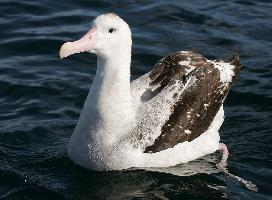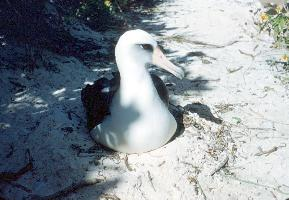
Váhy a míry
| Délka | 1,35 m |
|---|---|
| Hmotnost | od 6 do 12 kg |
Biologická data
| Délka života | 80 r |
|---|
Popis zvířete
The Wandering Albatross, scientifically known as Diomedea exulans, is a remarkable bird that commands the attention of birdwatchers and nature enthusiasts around the globe. This majestic species is not only one of the largest of the albatrosses but also holds the record for the longest wingspan of any living bird, which can reach up to an astonishing 3.5 meters (11.5 feet). These impressive wings enable the Wandering Albatross to glide effortlessly over the open ocean, sometimes for hours without a single flap, harnessing the wind's power with unparalleled mastery.Adult Wandering Albatrosses are predominantly white, with strikingly black-edged wings and a pale pink bill, which adds a delicate contrast to their otherwise imposing appearance. Juveniles start their lives with a much darker plumage, which gradually lightens as they age, a process that can take several years. This gradual transformation adds a layer of complexity to their identification in the wild.
The habitat of the Wandering Albatross is primarily the Southern Ocean and the North Atlantic, where they spend most of their lives at sea, coming ashore only to breed. They are known for their incredible long-distance flights, often circumnavigating the Southern Hemisphere, in search of food, which mainly consists of squid, fish, and krill. Their ability to travel vast distances has fascinated scientists and nature lovers alike, leading to extensive studies on their navigation and foraging strategies.
Breeding is a slow and meticulous process for the Wandering Albatross. They are monogamous birds, often forming lifelong bonds with their partners. Nesting sites are located on remote, sub-Antarctic islands, where each pair lays a single egg on a carefully constructed nest. Both parents share the responsibility of incubating the egg and later, feeding the chick, a process that can last over a year from laying to fledging. This extended parental care is necessary for the survival of the chick but also means that Wandering Albatrosses breed only every other year, contributing to their slow population growth.
The Wandering Albatross faces several threats, primarily from human activities. Longline fishing poses a significant risk, as birds can become accidentally hooked and drown. Additionally, pollution, especially plastic waste, can be fatal if ingested. Climate change also affects the distribution of their prey, potentially impacting their ability to find food. As a result, the Wandering Albatross is classified as vulnerable by the International Union for Conservation of Nature (IUCN), and conservation efforts are underway to mitigate these threats.
Conservation initiatives include international agreements to adopt bird-friendly fishing practices, strict monitoring of breeding sites, and research into their migration patterns to better understand their ecological needs. The allure of the Wandering Albatross, with its grace, endurance, and the mystery of its open-ocean lifestyle, continues to inspire efforts to ensure its survival in the face of growing environmental challenges.
In summary, the Wandering Albatross is a symbol of the wild, untamed nature of our planet's oceans. Its incredible journey through life, from a downy chick to a majestic adult soaring across the globe, mirrors the challenges and beauty found in the natural world. As efforts to protect this iconic species continue, the Wandering Albatross remains a beacon of hope for conservationists and a reminder of the importance of preserving our planet's incredible biodiversity.
Podobná zvířata
Nové fotografie zvířat
Top 10 zvířat
- Chinese water dragon (Physignathus cocincinus)
- Galápagos tortoise (Geochelone nigra complex)
- Dolphin gull (Leucophaeus scoresbii)
- Japanese macaque (Macaca fuscata)
- Colombian red howler (Alouatta seniculus)
- Sea urchins (Echinoidea)
- Moustached guenon (Cercopithecus cephus)
- Diana monkey (Cercopithecus diana)
- Common reed warbler (Acrocephalus scirpaceus)
- Common house mosquito (Culex pipiens)
